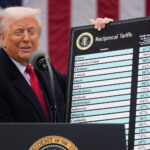WASHINGTON (AP) — Three lower courts have ruled illegal President Donald Trump’s use of emergency powers to impose worldwide tariffs. Now, the Supreme Court — with three justices Trump appointed and generally favorable to muscular presidential power — will have the final word.
In roughly two dozen emergency appeals, the justices have largely sided with Trump, allowing parts of his aggressive second-term agenda to take effect temporarily while lawsuits proceed. But the case being argued Wednesday marks the first time the court will render a final decision on a central Trump policy. The stakes are enormous, both politically and financially, as Trump has made tariffs a cornerstone of his economic and foreign policy, declaring it would be a “disaster” if the Supreme Court rules against him.
**What to Know: The Supreme Court Tariff Case**
**1. What Are Tariffs?**
Tariffs are taxes on imports, paid by companies that bring finished products or parts into the country. These costs are often passed on to consumers. Through September, the government reported collecting $195 billion in revenue from the tariffs.
**2. Who Has the Power to Impose Tariffs?**
The U.S. Constitution gives Congress the power to impose tariffs. However, Trump claimed extraordinary authority to act without congressional approval by declaring national emergencies under the 1977 International Emergency Economic Powers Act (IEEPA).
In February, Trump invoked the law to impose tariffs on Canada, Mexico, and China, stating that illegal immigration and drug flows across the U.S. border amounted to a national emergency. He further imposed global tariffs in April, declaring trade deficits a “national emergency.”
**3. Legal Challenges to Trump’s Tariffs**
Businesses and states backed by libertarian groups challenged Trump’s actions in court. Trump’s opponents won rulings from a specialized trade court, a Washington, D.C., district judge, and a business-focused appeals court. All found that Trump could not justify tariffs under the emergency powers law, which does not explicitly mention tariffs. However, these courts left the tariffs in place while legal proceedings continue.
The appeals court relied on the “major questions” doctrine — a legal principle set by the Supreme Court that requires Congress to speak clearly on issues of “vast economic and political significance.”
**4. The Major Questions Doctrine — and Its Precedents**
The ‘major questions’ doctrine has played a decisive role in high-profile cases. Conservative majorities on the court struck down three separate Biden-era initiatives related to the COVID-19 pandemic, ending a pause on evictions, blocking a vaccine mandate for large businesses, and preventing a $500 billion student loan forgiveness program.
In comparison, the stakes in the tariff case are much higher, with taxes estimated to generate $3 trillion over ten years. Challengers have pointed to writings by the three Trump appointees — Justices Amy Coney Barrett, Neil Gorsuch, and Brett Kavanaugh — urging the court to apply similar limitations to Trump’s policies.
Barrett, for example, used a babysitter analogy in the student loans case to stress the need for clear congressional instruction: “Permission to spend money on fun authorizes a babysitter to take children to the local ice cream parlor or movie theater, not on a multiday excursion to an out-of-town amusement park,” Barrett wrote.
Kavanaugh, though, has suggested the court should not apply the same restrictive standard to foreign policy and national security.
**5. Congress’s Power to Delegate**
Some business plaintiffs are advancing a separate argument appealing to conservative justices: that Congress cannot constitutionally delegate its taxing authority to the president. The so-called nondelegation principle has not been used in 90 years, since the Supreme Court struck down some New Deal laws. However, Gorsuch authored a recent dissent arguing that Congress ceding too much lawmaking power to the executive branch is unconstitutional, with Justices Samuel Alito and Clarence Thomas joining.
**6. An Unusually Fast Turnaround**
The Supreme Court only agreed to hear the case in September, scheduling arguments in under two months — a notably quick turnaround. This suggests the court may act faster than usual, as high-profile cases can typically take half a year or more for a final decision due to extended drafting of majority and dissenting opinions.
Showing how quickly it can move under deadline pressure, the court recently ruled just a week after arguments in the TikTok case, unanimously upholding a law that requires the social media app to be banned unless sold by its Chinese parent company. Trump himself has intervened multiple times to keep the law from taking effect while negotiations continue with China.
**Stay Tuned**
The Supreme Court’s impending decision could have far-reaching effects on U.S. economic policy and presidential authority — as well as the pocketbooks of American businesses and consumers.
https://ktar.com/national-news/what-to-know-about-the-supreme-court-arguments-over-trumps-tariffs/5770683/

Be First to Comment